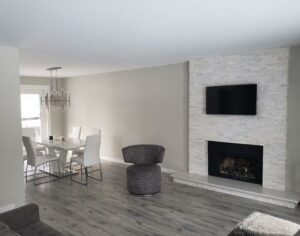06 Dec The Art Of Faux Finishes: Creating Texture & Elegance

There’s a lot of power in paint. From bold accents to simple neutral tones, a fresh coat can refresh, revitalize, and even completely transform a space.
But did you know that paint can also effectively mimic other finishes?
Below, we’ve provided an overview of faux painting techniques, explored their benefits, and offered a few tips and tricks to get you started. Want to learn more about professional faux finishes? Contact our team at Pinnacle Painting today!
What Are Faux Finishes?
A faux finish is a decorative painting technique that adds depth and interest to an otherwise flat surface. In French, the word “faux” means fake and, indeed, many faux finishes mimic other, more expensive materials, such as marble, wood, stucco, or wallpaper.
Various faux painting techniques have been popular throughout history in different regions of the world, with the oldest known examples mimicking plaster and stucco finishes in ancient Mesopotamia!
Today, faux finishes are achieved using materials like paint, glaze, and sealant in combination with tools such as brushes, sponges, rags, rollers, and even combs.
The Benefits of Faux Finishes
Wondering what benefits faux finish painting has to offer? Let’s take a look:
- Versatile – Marble, wood, stucco, or fabric—with faux painting, you can achieve all of these effects plus more.
- Economical – Don’t have the budget for high-end finishes? If you know how to wield your paintbrush effectively, you can create an affordable alternative.
- Customized – Looking to maintain a specific colour scheme or match a pre-existing motif? With faux finishes, your imagination is the only limitation.
- Multi-Dimensional – Achieve appealing depth and texture with simple techniques that will catch the eye.
Faux Finishing Techniques
Below is a small sampling of some popular faux finishing techniques, but with a little research, you can discover many more:
Wood Graining
In this technique, you’ll apply a thin layer of glaze over a base coat and use a wood grain rocker to create a wood-like texture while the glaze is still wet.
Sponging, Ragging, and Dragging
Oh my! Though they may sound a little silly, these simple techniques are popular and highly effective:
- Sponging – Use a natural sea sponge to create a mottled texture on walls, ceilings, and/or furniture.
- Ragging – Often used to replicate fabric, this technique simply involves manipulating glaze with a dry rag.
- Dragging – Drag a dry brush or comb through wet glaze to create a dynamic texture that can add a subtle sense of motion to an otherwise stationary surface.
Stencilling
Purchase or design your own stencils to make a one-of-a-kind faux painting statement.
Faux Finishing Tips
- Clean and prep surfaces properly.
- Ensure your base coat is completely dry before adding glaze.
- Refine your colours and technique on a practice surface before tackling a larger project.
- Less is more; sometimes too much texturing on painted walls can feel overwhelming, especially in small spaces.
Interested in exploring a faux painting technique but not sure where to begin? As experienced residential and commercial painters in Winnipeg, our professional team at Pinnacle Painting and Decorating can bring your visions to life. Contact us today to learn more!
